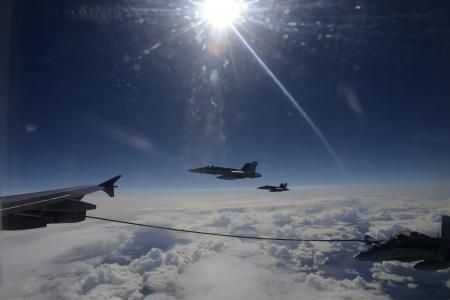
The joint military drill kicked off on August 26, with scenarios that required the United States, Canada and Russia to respond to simulated terrorist hijackings of commercial aircraft. Both NORAD, a bi national command of the United States and Canada, and Russia had to scramble fighter jets and track and intercept the "hijacked aircraft."
Just concluding the most ambitious Vigilant Eagle exercise yet, NORAD's operations director Canadian Major General Andre Viens and Russian Commander Gen. Maj. Dmitry Gomenkov told reporters they are ready to take the lessons learned to make next year's exercise even more challenging.
Throughout the exercise series, the participants have developed tactics, techniques and procedures to effectively notify, coordinate, and conduct positive hand-off of a hijacked aircraft flying through Russian, Canadian and American airspace, Viens told reporters during a teleconference.
Vigilant Eagle 13 offered the opportunity to take principles proven in a simulated environment during last year's command post exercise, and to validate them during the third "live-fly" exercise since the exercise series began in 2008, Viens and Gomenkov reported.
Canadian fighter jets participated for the first time in this year's Vigilant Eagle exercise, with Canadian CF-18 Hornets and Russian Su-27 Sukhois aircraft following and intercepting the "hijacked" aircraft, Gomenkov noted.
The exercise delivered another first, with a visual fighter-to-fighter hand off of escort responsibilities in a live-fly situation as the "track of interest" moved from one country's airspace to another's.
For the first time, fighters of all the three countries joined together to have a positive hand off of escort responsibility on a track of interest. That crucial step forward in the Vigilant Eagle series required extensive planning and coordination to ensure a safe, successful transfer, Viens said.
"We have never done this together in the past, and it went off without a hitch," Viens said. "What this has enabled us to do is have 100 percent control over an aircraft in trouble that is flying between Russian, American and Canadian airspace. Working together as partners in the air and on the ground, we were able to ensure the safety of the civilians in the aircraft, our collective citizens and the safe landing of the aircraft at its destination."
Gomenkov praised the professionalism of all the three militaries throughout the exercise planning and said he looked forward to seeing the Vigilant Eagle series continue to build in complexity.
Planning for Vigilant Eagle 14 is scheduled to begin in November, Gomenkov said, noting that both Russia and NORAD will offer suggestions on how to build on this year's exercise.
Exercising together builds confidence and understanding that enables the United States, Canada and Russia to operate together more effectively, Viens said. "So clearly from a NORAD perspective, there is a great deal of interest to continue this tradition of Vigilant Eagle exercises to further promote cooperation, especially when it comes to air-space activities that require the attention of both Russia and NORAD," he said.



Reader Comments
to our Newsletter